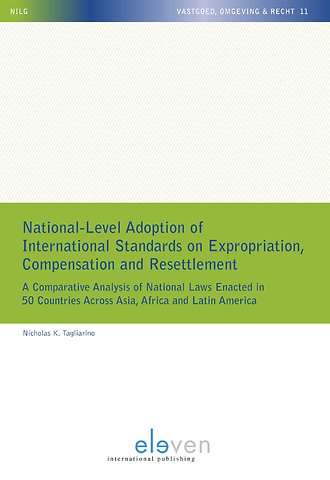National-Level Adoption of International Standards on Expropriation, Compensation and Resettlement
A Comparative Analysis of National Laws Enacted in 50 Countries Across Asia, Africa and Latin America
Samenvatting
This book presents the first-ever comprehensive assessment of whether national laws enacted in 50 countries across Asia, Africa, and Latin America comply with international standards on expropriation, compensation, and resettlement as established in Section 16 of the Voluntary Guidelines on the Responsible Governance of Tenure of Land, Fisheries, and Forests in the Context of National Food Security (VGGTs). The VGGTs are supported by the international consensus of governments, civil society, and the private sector. The UN Committee on World Food Security officially endorsed the VGGTs in 2012.
This book uses indicators to compare laws with international standards. Illustrative examples of how expropriation laws are implemented in practice, including a case study of Nigeria’s Lekki Free Trade Zone expropriation case, are provided to highlight the importance of adopting international standards. Along with establishing a benchmark for measuring progress that indicates most of the national laws assessed do not comply with international standards, this book offers a set of recommended legal reforms that support the adoption of international standards in national laws.
Trefwoorden
Specificaties
Inhoudsopgave
List of Acronyms xvii
1 Introduction 1
1.1 What Is the Objective of the Study? 1
1.2 Definition of Terms 2
1.3 Why Does This Study Focus on the Law? 8
1.4 What Is Covered by This Study? 9
1.5 How Were the 50 Countries Chosen? 10
1.6 Why Does This Study Include a Case Study of Nigeria? 11
1.7 Why Does This Study Focus on the VGGTs? 12
1.8 What Is the Methodology Used to Assess National Laws in This Study? 17
1.9 What Are the Caveats and Research Limitations? 19
1.10 Who Can Benefit from This Research? 22
1.11 Roadmap 24
2 Legal Limits on the Government’s Authority to Expropriate Land 27
2.1 Summary and Roadmap 27
2.2 Background and Context Regarding Expropriation Decision-Making 27
2.3 VGGTs on Expropriation 36
2.4 Findings on Public Purpose Decision-Making 37
2.4.1 Requirements to Minimize Expropriated Land 40
2.4.2 Proportionality Test and Feasibility Study 41
2.5 Limitations on the Type of Land That Can Be Expropriated 42
2.5.1 Social and Environmental Impact Assessments 43
2.5.2 Special Protections for Poor and Vulnerable Groups, Such as Indigenous Peoples 45
2.5.3 Reacquisition Rights 47
2.6 Legal Provisions That Help Ensure a Transparent and Participatory Expropriation Process 48
2.6.1 Identifying Affected Landholders 49
2.6.2 Informing Affected Landholders of the Reasons for the Expropriation 50
2.6.3 Consulting Affected Landholders Prior to the Expropriation 51
2.7 Suggested Avenues for Lawmakers to Pursue 53
3 Compensation Eligibility Requirements 55
3.1 Summary and Roadmap 55
3.2 Background and Context Related to Compensation Eligibility Requirements 56
3.3 The Right to Compensation as Established by the VGGTs and Other International Instruments 59
3.4 Explanation of Why This Chapter Incorporates Findings from Land-Mark’s Legal Indicators 61
3.5 Research Findings and Analysis 63
3.5.1 Compensation for Formally Recognized Tenure Rights Held by IPLCs 63
3.5.2 Compensation for Unregistered IPLC Tenure Rights 66
3.5.3 Compensation for Formally Recognized IPLC Tenure Rights Regardless of Whether the Land Is Developed, Cultivated, or Has Improvements 70
3.6 Additional Limitations on IPLC Rights to Compensation 72
3.6.1 Legal Definition of ‘Community Land’ 72
3.6.2 Time Requirements 75
3.7 Suggested Avenues for Lawmakers to Pursue 76
4 Compensation Valuation Procedures 79
4.1 Summary and Roadmap 79
4.2 Background and Context Related to Compensation Valuation Procedures 79
4.3 Standards on Compensation Valuation Established in the VGGTs 81
4.4 Research Findings and Analysis 82
4.4.1 Compensation for Poor and Marginalized Groups 83
4.4.1.1 The ‘Fair Market Value’ Approach 83
4.4.1.2 Special Protections Ensuring Women Landholders Receive Fair Compensation 88
4.4.2 Valuation of Compensation 90
4.4.2.1 Compensation for Loss of Economic Activities and Improvements Made on the Land 91
4.4.2.2 Compensation for Intangible Land Values (e.g., Cultural, Spiritual, and Historical Values) 93
4.4.2.3 The Right of Affected Populations to Opt for Alternative Land Instead of or in Addition to a Cash Payment of Compensation 95
4.4.3 Prompt Payment and Objective Assessment of Compensation 98
4.4.3.1 The Affected Populations’ Right to Negotiate Compensation Amounts 98
4.4.3.2 Delays in Compensation Payments 101
4.4.3.3 A Right to Challenge Compensation Decisions in Court or before a Tribunal 102
4.4.4 Overall Conclusions from the Nine Compensation Valuation Indicators 104
4.5 Suggested Avenues for Lawmakers to Pursue 105
5 Resettlement Procedures 109
5.1 Summary and Roadmap 109
5.2 Background and Context on Resettlement 109
5.3 International Standards on Resettlement 114
5.3.1 VGGTs on Resettlement 114
5.3.2 World Bank Environmental and Social Framework (ESF) 115
5.3.3 IFC Performance Standard 5 119
5.3.4 Regional Development Bank Policies 121
5.3.5 Bilateral Institutional Policies 122
5.3.6 Resettlement Guidance in International Human Rights Instruments 122
5.4 Literature on the Gap between National-Level Resettlement Procedures and International Standards 123
5.5 Findings on Resettlement Procedures in National Laws 124
5.5.1 Legally Binding Resettlement and Rehabilitation Procedures 125
5.5.2 Relocation Allowance 128
5.5.3 A Right to Alternative Land and/or Housing That Is Suitable or Productive 130
5.5.4 Consulting Displaced Populations during the Resettlement Process 132
5.5.5 Requirement to Minimize or Avoid Involuntary Resettlement 134
5.5.6 Sufficient Funding to Implement Resettlement Programs 136
5.6 Suggested Avenues for Lawmakers to Pursue 137
6 The Laws and Practices Related to Land Expropriation in Nigeria: The Case of the Lekki Free Trade Zone (LFTZ) in Lagos 141
6.1 Summary and Roadmap 141
6.2 Legal Reform as a Solution to Arbitrary Expropriation and Insufficient Compensation in Nigeria 142
6.3 Empirical Research on Expropriations and Forced Evictions in Nigeria 143
6.3.1 Forced Evictions in Abuja 144
6.3.2 Forced Evictions in Lagos 145
6.4 Comparative Legal Analysis of Nigeria’s LUA with the Section 16 VGGTs 146
6.4.1 Definition of Public Purpose 149
6.4.2 Limitations on the Amount or Type of Expropriated Land 151
6.4.3 The Process of Expropriating Land 153
6.4.4 Compensation for Unregistered Landholders 154
6.4.5 Valuation of Compensation 155
6.4.6 Prompt Payment of Compensation 157
6.4.7 A Right to Negotiate Fair Compensation 158
6.4.8 The Right to Challenge Compensation Decisions in Court or before Tribunals 159
6.4.9 Provision of Productive Alternative Land 159
6.4.10 Summary of Legal Analysis 160
6.5 Examination of LFTZ Case 162
6.5.1 Background on the Development of the LFTZ 162
6.5.2 MOU between LWIL, LSG, and Affected Communities 165
6.5.3 Background on the Survey of Affected Communities 167
6.5.4 Access to Information and Participation during the Expropriation Process 171
6.5.5 Compensation Paid for Crops 172
6.5.6 Possible Corruption 178
6.5.7 Environmental Impact Assessment (EIA) 178
6.5.8 Alternative Land 179
6.5.9 Jobs and Equity Shares 180
6.5.10 Displacement of the Illekuru Community 180
6.6 Suggested Avenues for Nigerian Lawmakers to Pursue 182
7 Conclusion and Recommendations 187
7.1 Summary and Roadmap 187
7.2 Summary of the Findings 187
7.2.1 Findings on Public Purpose Decision-Making (Chapter 2) 187
7.2.1.1 Limits on the Type and Amount of Land That Can Be Expropriated 188
7.2.1.2 Transparent and Participatory Expropriation Process 190
7.2.1.3 Recommendations from Chapter 2 191
7.2.2 Compensation Eligibility Indicator Findings (Chapter 3) 192
7.2.2.1 Recommendations from Chapter 3 195
7.2.3 Compensation Valuation Indicator Findings (Chapter 4) 196
7.2.3.1 Recommendations from Chapter 4 200
7.2.4 Resettlement Indicator Findings (Chapter 4) 201
7.2.4.1 Recommendations from Chapter 5 204
7.2.5 Examination of the Laws and Practices Related to Expropriation in Nigeria (Chapter 6) 206
7.2.5.1 Analysis of the Expropriation and Compensation Practices Followed in the LFTZ Expropriation Case 207
7.2.5.2 Recommendations from Chapter 6 208
7.3 Overall Findings from the Indicator Analysis 209
7.4 Concluding Remarks and Suggested Areas of Future Research 211
Bibliography 215
Appendix 259
Anderen die dit e-book kochten, kochten ook
Net verschenen
Rubrieken
- aanbestedingsrecht
- aansprakelijkheids- en verzekeringsrecht
- accountancy
- algemeen juridisch
- arbeidsrecht
- bank- en effectenrecht
- bestuursrecht
- bouwrecht
- burgerlijk recht en procesrecht
- europees-internationaal recht
- fiscaal recht
- gezondheidsrecht
- insolventierecht
- intellectuele eigendom en ict-recht
- management
- mens en maatschappij
- milieu- en omgevingsrecht
- notarieel recht
- ondernemingsrecht
- pensioenrecht
- personen- en familierecht
- sociale zekerheidsrecht
- staatsrecht
- strafrecht en criminologie
- vastgoed- en huurrecht
- vreemdelingenrecht









